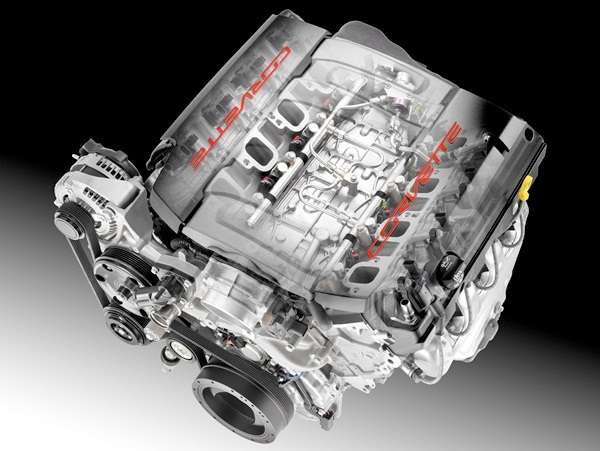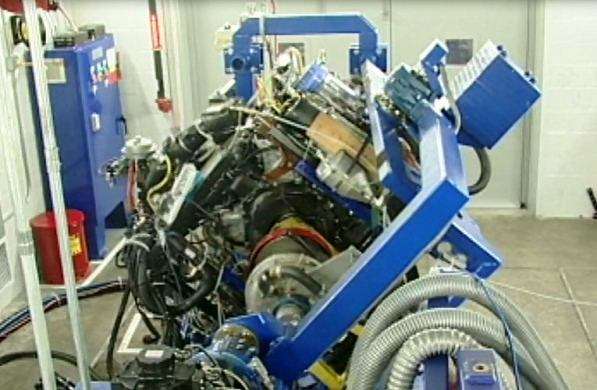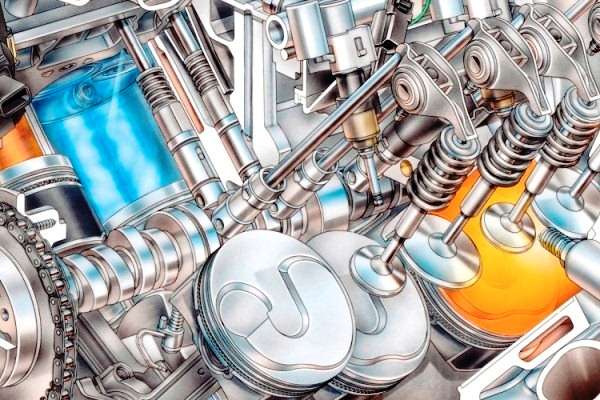
Chevy Gen V Small-block - LT1
#1

Posted 24 October 2012 - 15:40
Anyone care to speculate on why Chevy reversed the intake/exhaust valve order from the LS series?
Possibly to make more room in the head casting for the DI? Note that the spark plug is also reversed......it's now pointing towards the intake valve as opposed to the exhaust valve on the LS.
John
Advertisement
#2

Posted 24 October 2012 - 17:54
Why do they still angle the valves?
Thats why they have to add a chunk of aluminium to the pistons.
Not a fan of the piston. But i think i understand what you can do with it.
Edited by MatsNorway, 24 October 2012 - 18:15.
#3

Posted 24 October 2012 - 18:05
Very nice to see GM are still using Dave Kimble to do cutaways
#4

Posted 24 October 2012 - 18:41
The claimed weight is 465lb or 211kg , the original small block of the 50's was usually quoted as 540lb/245kg but not sure what dress level ror both engines
http://www.freep.com...g-step-forward-
#5

Posted 24 October 2012 - 19:59
Chevy Gen V Small-block Reveal
Anyone care to speculate on why Chevy reversed the intake/exhaust valve order from the LS series?
Possibly to make more room in the head casting for the DI? Note that the spark plug is also reversed......it's now pointing towards the intake valve as opposed to the exhaust valve on the LS.
John
That's exactly why. Stay tuned for the in-depth at MCG.
#6

Posted 24 October 2012 - 20:50
That's exactly why. Stay tuned for the in-depth at MCG.
Alright.....thanks!
#7

Posted 24 October 2012 - 22:34
Having played with quite a few of the original SBC blocks weigh up to 40lbs different. Newer are generally lighter and fat thinner in cylinder walls. Heads, cranks, rods vary a bit and accesories do too. Z28 and LT1 used alloy intakes, as did later engines. There can probably be up to 80lbs difference.As ever in things Detroit the Detroit Free Press has the answer !
The claimed weight is 465lb or 211kg , the original small block of the 50's was usually quoted as 540lb/245kg but not sure what dress level ror both engines
http://www.freep.com...g-step-forward-
The alloy engines do vary quite a lot too, depending on year and spec.
A few years back Sprintcar engines were almost more what does it weigh than power. There was some very silly choices made but everything has settled down these days. Though weight still is a main consideration.
#8

Posted 24 October 2012 - 23:27
#9

Posted 24 October 2012 - 23:35
How much of this engine is metric? Bore and stroke, valve sizes etc seem to be metric!!!!!
I think GM ( and all of Detroit) has been metric for many years - The 84 C4 vette chassis was certainly 100% metric .
Magoo?
#10

Posted 25 October 2012 - 00:04
#11

Posted 25 October 2012 - 00:22
Including fasteners etc?
I can verify that the C4 chassis fasteners are indeed metric!
Edited by NTSOS, 25 October 2012 - 00:36.
#12

Posted 25 October 2012 - 08:12
Chevrolet Gen 5 Small Block V8 revealed | Mac's Motor City Garage.com
This is the first in-depth feature on the engine. There's more material to come on various subsystems and so on, as well as some of the new development tools used, which are rather interesting.

.
#13

Posted 25 October 2012 - 08:57
I dont know is any future hot rodders will junk it for port injection, but the whole direct injection system looks very neat. pump cams directy on the big single cam and very short runs for the high pressure lines.
Lets hope with all GM's crises and changes they have still designed-in the original SB reliabilty and fixabilty.
I admit to being an unashamed SB fan- it still sounds as if the old rule is true - if you can get a 24"/600mm cube cardboard box in the engine bay you've got 500 bhp no sweat!
#14

Posted 25 October 2012 - 11:07
I think GM ( and all of Detroit) has been metric for many years - The 84 C4 vette chassis was certainly 100% metric .
Magoo?
The first metric GM platform in North America was the 1977 B and C body. (B = Chevy Impala; C = Buick Park Ave.) From that point on, each new platform or engine was done in metric, but it still took decades to complete the changeover because engines like the SBC hung on for decades.
In the case of the C4 Corvette, that car was indeed 100 percent metric but not the engine. Here you would find English fasteners and dimensions inside the engine, but the tapped holes on the exterior of the engine would be metric. Ford and Chrysler employed similar changeover schemes.
Personally, I never found any particular hardship with it...rather instructional, actually. I can still identify English vs. metric fastener heads and thread forms at 10 feet away. Also, metric fasteners were coated blue, which tended to make things much easier than they could have been.
The LS series GM V8s, starting in 1997 and including this one, were all 100 percent metric from the start. But this is interesting: It was Gen III and then Gen IV V8 (Roman numerals) but this latest one introduced yesterday is Gen 5. There's always something, I suppose.
Edited by Magoo, 25 October 2012 - 11:07.
#15

Posted 25 October 2012 - 15:26
Video: GM's Tilt-a-Whirl engine dyno | Mac's Motor City Garage.com

#16

Posted 25 October 2012 - 22:06
Thanks, Magoo - very nice and informative article.
I dont know is any future hot rodders will junk it for port injection, but the whole direct injection system looks very neat. pump cams directy on the big single cam and very short runs for the high pressure lines.
Thanks for the kind words.
I think boost and other >fuel mass applications will have to piggyback additional manifold or port injectors on top of the DI, at least in the near term.
As yet I don't believe the aftermarket has real DI capability. But of course, they always manage to crack everything eventually, one way or another.
#17

Posted 25 October 2012 - 22:15
So Detroit is going/has gone metric. Is this dragging the rest of America out of the dark ages? I know we still have to deal with some imperial stuff here in Oz despite being "officially" metric for 30 or 40 years now.The first metric GM platform in North America was the 1977 B and C body. (B = Chevy Impala; C = Buick Park Ave.) From that point on, each new platform or engine was done in metric, but it still took decades to complete the changeover because engines like the SBC hung on for decades.
In the case of the C4 Corvette, that car was indeed 100 percent metric but not the engine. Here you would find English fasteners and dimensions inside the engine, but the tapped holes on the exterior of the engine would be metric. Ford and Chrysler employed similar changeover schemes.
Personally, I never found any particular hardship with it...rather instructional, actually. I can still identify English vs. metric fastener heads and thread forms at 10 feet away. Also, metric fasteners were coated blue, which tended to make things much easier than they could have been.
The LS series GM V8s, starting in 1997 and including this one, were all 100 percent metric from the start. But this is interesting: It was Gen III and then Gen IV V8 (Roman numerals) but this latest one introduced yesterday is Gen 5. There's always something, I suppose.
I wonder how many billions we waste through lack of worldwide standardisation - Metric/imperial, 110V/240V, Left-hand-drive/RHD . . . . . .
I feel a new thread coming on.
#18

Posted 25 October 2012 - 23:12
So Detroit is going/has gone metric. Is this dragging the rest of America out of the dark ages? I know we still have to deal with some imperial stuff here in Oz despite being "officially" metric for 30 or 40 years now.
I wonder how many billions we waste through lack of worldwide standardisation - Metric/imperial, 110V/240V, Left-hand-drive/RHD . . . . . .
I feel a new thread coming on.
In the USA, science and industry have long since gone metric. However, retail commerce and the general population insist upon keeping their English measures. They seem very convinced they have an effective and totally sensible system. What do you propose to do? Shoot them? Jail them? Send them to the gulag until they can be reeducated?
At some point we need to ask what systems of measurement are for. Sorry if that conflicts with your sense of order. You know, billions are wasted each year through poor card playing. What is to be done?
#19

Posted 26 October 2012 - 02:13
I would like to know the dimensions and all up weight to see how much - if any - packaging advantages are retained by the good ole' two valve + pushrod layout.
http://bioage.typepa...a110e970d-800wi
Most people fail to appreciate the package size, weight and cost levels that a 2-valve pushrod/rocker arm V8 can still achieve. My guesses as for the reasons the porting was altered are to make room for direct injection hardware, and/or to minimize the flow disturbances caused by cylinder deactivation.
It's a very nice engine design. I applaud GM's engineers for eschewing the conventional wisdom regarding cylinder head and valvetrain architectures.
slider
Advertisement
#20

Posted 26 October 2012 - 03:00
I am interested to know how metrication is proceeding in the US. Has any change been legislated? In Oz we are are now down to two categories.In the USA, science and industry have long since gone metric. However, retail commerce and the general population insist upon keeping their English measures. They seem very convinced they have an effective and totally sensible system. What do you propose to do? Shoot them? Jail them? Send them to the gulag until they can be reeducated?
- The young who know little or nothing of the imperial system. What awareness they have is largely through exposure to US products, media etc.
- An older generation (including myself) who were originally exposed to the imperial system then went through a metricated education system. I still automatically judge some things (a person's height but not their weight???, altitude) in imperial units.
There used to be a third category of die-hard "imperialists" but even these have been forced to metricate to a large extent just to cope with shopping, road signs, speedometers etc.
So once you legislate metrication of commerce, industry and government, the die-hards will follow.
BTW. Have you managed to get rid of the penny yet? I remember when that was proposed a few years ago it was rejected as a money-grabbing plot. I can remember back to when Oz had halfpennies. We lost them in 1966 with the intro of decimal currency then the 1c coin (we never called them pennies) and 2c coin were withdrawn in 1992. We gained a $1 and $2 coin (and lost the corresponding notes) and probably gained some higher denomination notes. It doesn't really make sense to keep denominations once inflation renders them almost worthless.
Edited by gruntguru, 26 October 2012 - 03:01.
#21

Posted 26 October 2012 - 03:26
It's somewhat curious to note that the new updated LSX blocks and heads have 6 bolts per cylinder, but the LT1 design team chose to to stay with 4 bolts per cylinder, though they did increase the bolt size from 11 to 12mm.
John
#22

Posted 26 October 2012 - 03:28
#23

Posted 26 October 2012 - 08:05
It turned out he was working in feet. Nobody works in feet. I hope he likes his garden ornament! (4 tonnes of concrete in the shape of Mt Fuji)
#24

Posted 26 October 2012 - 10:09
It's somewhat curious to note that the new updated LSX blocks and heads have 6 bolts per cylinder, but the LT1 design team chose to to stay with 4 bolts per cylinder, though they did increase the bolt size from 11 to 12mm.
John
The extra row of screws in the LSX block doesn't do a whole lot. It's mainly for extreme boost applications.
#25

Posted 26 October 2012 - 10:37

#26

Posted 26 October 2012 - 13:19
The extra row of screws in the LSX block doesn't do a whole lot. It's mainly for extreme boost applications.
I wonder if a "LT9" supercharged version is in the plan for a ZR1 upgrade?
Thanks!
John
#27

Posted 26 October 2012 - 13:41
The Active Fuel Management (DoD) and CVVT are important, but here is the key to the deal: the direct injection and advanced combustion strategy, which allows 11.5:1 CR. (Yes, that's my hand.) The cylinder head redesign, including the intake/exh port swap, was all about accommodating the direct injectors and getting the spark plug out into the center of the chamber.
Access to LT1 pieces and parts....cool! Any chance for a photo of the inside of the air box?
John
#28

Posted 26 October 2012 - 23:03
Access to LT1 pieces and parts....cool! Any chance for a photo of the inside of the air box?
John
Nothing very useful at the moment but there's a big SAE paper coming. Stay tuned.
#29

Posted 27 October 2012 - 00:34
Nothing very useful at the moment but there's a big SAE paper coming. Stay tuned.
#30

Posted 27 October 2012 - 11:55
In the case of the C4 Corvette, that car was indeed 100 percent metric but not the engine. Here you would find English fasteners and dimensions inside the engine, but the tapped holes on the exterior of the engine would be metric. Ford and Chrysler employed similar changeover schemes.
"English fasteners" - as in BSW, BSF? Or was it UNC/UNF?
#31

Posted 27 October 2012 - 21:43
#32

Posted 28 October 2012 - 00:01
Good point. Don't forget BSP vs NPT. Very frustrating.
BSP is also, now, the standard metric pipe thread, as I am sure you know.
I work for a mining equipment manufacturer in Australia. Our equipment is designed and specified in metric units, but the threads can be either metric or imperial (UNC) depending on the customer. Customers from Australia will often use UNC threads because they use equipment from the US and/or older equipment and have stocks of parts using that standard. Occasionally SAE/NPT pipe threads will also be specified.
The US adopted a number of "English" units, but somehow they ended up being different. The gallon, for example. Why did that differ from the UK and the US?
A while ago on another forum a couple of guys were arguing about the fuel consumption of a particular airframe. One was American and the other British, and they argued about air miles per gallon. Problem was one was talking of air miles per UK gallon and the other in air miles per US gallon.
I also understand that once upon a time the US inch was different to the UK inch, but that was quickly standardised.
#33

Posted 28 October 2012 - 01:26
Weights and measures are an endlessly fascinating topic with a tremendous amount of history and culture behind them. One could make a pretty nice little pastime out of studying just the various systems of engine output. For example, historically there are different types of horsepower for tractors, ships, aircraft, etc. Then you have all the different national standards as well as various schemes for taxable hp and so on. Fine fun.
I know I've shared this link here several times before but it really is a great read.
http://www.unc.edu/~rowlett/units/
#34

Posted 28 October 2012 - 01:49
I am interested to know how metrication is proceeding in the US. Has any change been legislated? In Oz we are are now down to two categories.
- The young who know little or nothing of the imperial system. What awareness they have is largely through exposure to US products, media etc.
- An older generation (including myself) who were originally exposed to the imperial system then went through a metricated education system. I still automatically judge some things (a person's height but not their weight???, altitude) in imperial units.
There used to be a third category of die-hard "imperialists" but even these have been forced to metricate to a large extent just to cope with shopping, road signs, speedometers etc.
So once you legislate metrication of commerce, industry and government, the die-hards will follow.
gruntguru-
Contrary to what magoo claims, there has not been much acceptance of the metric system in the US. Back in the mid 70's, the US federal government legislated a changeover to the metric system. But it was mostly ignored by industry and the general public. Even today, the only industry that has fully adopted the metric system is the auto industry. Most aerospace and defense is still inches and pounds. Domestic commerce and trade is also still conducted in pounds and gallons.
When took engineering classes 25 years ago, it was all taught using the metric system. So I'm perfectly comfortable using it. But my engineering job in aerospace still requires use of inches and pounds. In the end it doesn't matter much, it's all just numbers. Claiming the metric system is superior because it is the system used by most of the world would be like saying the US dollar is the superior currency because it is the denomination used most widely for global commerce.
Regards,
slider
#35

Posted 28 October 2012 - 04:12
I would never do that. No, the metric system is superior for its simplified conversions, arising largely from the choice of sensible standard units to start with. It is very convenient for example that 1 Volt x 1 Ampere = 1 Watt = 1 m/s x 1 Newton. The vast majority of units can be derived from the metre, the kilogram and the second. The other simplification of course is the metric convention of using only 10 as a multiplier - from the micron to the kilometer - and beyond - in both drections - all you need to do is shift the decimal point. Contrast that to inches, feet, yards, miles then add a dimension to acres and again to pints, quarts, gallons etc.Claiming the metric system is superior because it is the system used by most of the world would be like saying the US dollar is the superior currency because it is the denomination used most widely for global commerce.
In OZ, we changed from a currency sytem of pounds, shillings and pence (20 shillings/pound and 12 pence per shilling) to one of dollars and cents back in 1966. I can assure you that the dollar is superior - again for reasons of convenience. The British had a similar experience when they changed to the decimal pound.
#36

Posted 28 October 2012 - 05:35
gruntguru-
Contrary to what magoo claims, there has not been much acceptance of the metric system in the US. Back in the mid 70's, the US federal government legislated a changeover to the metric system. But it was mostly ignored by industry and the general public. Even today, the only industry that has fully adopted the metric system is the auto industry. Most aerospace and defense is still inches and pounds. Domestic commerce and trade is also still conducted in pounds and gallons.
When took engineering classes 25 years ago, it was all taught using the metric system. So I'm perfectly comfortable using it.
You could pay closer attention to what happens in your own country -- and in your own posts. Look at the large, amusing contradiction you wrote.
#37

Posted 28 October 2012 - 06:00
"English fasteners" - as in BSW, BSF? Or was it UNC/UNF?
I say English as opposed to British. BSW and BSF thread forms are fairly rare but by no means unheard of in the USA. Imperial measures and inch/fractional (like UNC/UNF) are often called "English" here in the USA. When metric standards were first popularized here in the 1970s, they were commonly referred to as "European." Prior to metric, UNC and UNF fasteners were nearly universal in the auto industry, for example in the SBC.
To this day, the nut and bolt racks in retail hardware stores are predominantly UNC/UNF -- where UNC popularly is called USS and UNF is called SAE...their former official designations, more or less. But not exactly.
#38

Posted 28 October 2012 - 06:55
I wonder if a "LT9" supercharged version is in the plan for a ZR1 upgrade?
Thanks!
John
Yep. The Gen 5 is intended to replace the various Gen III/Gen IV V8s in all applications across the board. Cadillac, Camaro, truck, etc.
#39

Posted 28 October 2012 - 07:03
In the hardware stores in Australia UNF is just about extinct. I went looking through the new mega hardware store the other day for some UNF bolts and they had none at all in the little plastic packs, just Metric and Whitworth.To this day, the nut and bolt racks in retail hardware stores are predominantly UNC/UNF -- where UNC popularly is called USS and UNF is called SAE...their former official designations, more or less. But not exactly.
Advertisement
#40

Posted 28 October 2012 - 07:17
In the hardware stores in Australia UNF is just about extinct. I went looking through the new mega hardware store the other day for some UNF bolts and they had none at all in the little plastic packs, just Metric and Whitworth.
I would think that the fine threads are rarer than the standard coarse threads for each system.
#41

Posted 28 October 2012 - 11:38
Oh, and you will definitely want to see this related story, too.
Video: GM's Tilt-a-Whirl engine dyno | Mac's Motor City Garage.com
I thought this item might generate more interest here. Comments? Observations?
#42

Posted 28 October 2012 - 11:42
I also understand that once upon a time the US inch was different to the UK inch, but that was quickly standardised.
There where Danmark inches, swedish inches and norwegian inches separate to the other inches. And the list continues.
The norwegian inch.
Native: "Tomme" was 26.1mm
thumb is tommel in Norway.
More history here.
http://en.wikipedia...._of_measurement
We may argue now. But in the future we will perhaps look back and think.. "why on earth did we not do that before"
Edited by MatsNorway, 28 October 2012 - 11:42.
#43

Posted 28 October 2012 - 11:54
I thought this item might generate more interest here. Comments? Observations?
I like that they are pursuing high CR. I like that they are going DI. i like that the rockers are evenly spaced out.
And i like that the intake channel is getting straighter. Some remember the thread about Racing V8s. where i touched upon this topic.
That said i like it for the hp gains it could provide. I allways do.
I think that in time the emission demands might force a separate exhaust cam. i wonder if they would still do push rod with that. The gains would be lesser in weight.
I am a bit dissapointed to not see any variable lift from them. Only timing chances. they probably got the most space to do such things out of any motor.
when it comes to trowing the motor around it should be industry standard. So goes for the entire car. At least for the more costly models.
Edited by MatsNorway, 28 October 2012 - 11:56.
#44

Posted 28 October 2012 - 12:50
It would would be quite interesting to do an speadsheet analysis of different types of engine, pushrod 2V, DOHC 4V, turbo, V-8 NA at a similar power to see how much net benefit DOHC 4 valves and turbos etc acheive in fuel effiicency terms now there is a new V-8 two valve with a high ( 11.50) CR and VVT and DI.
This is the first time somebody has tried hard to do a new pushrod two valve for a long time so it is on a more equal playing field than legacy pushrod engines.
I presume that GM intend to use this in a lot more product than the Vette. I think a new Silverado is due out in 2013 and I guess a V-8 is esential for that market , both image, noise and heavy load pulling power. IIRC teh Silverado truck line does about 300K units per year for GM ,all very proftable.
#45

Posted 28 October 2012 - 13:41
The rolilng dyno is cool, I would presume it is also a wise test for serious off road SUV's.
It would would be quite interesting to do an speadsheet analysis of different types of engine, pushrod 2V, DOHC 4V, turbo, V-8 NA at a similar power to see how much net benefit DOHC 4 valves and turbos etc acheive in fuel effiicency terms now there is a new V-8 two valve with a high ( 11.50) CR and VVT and DI.
This is the first time somebody has tried hard to do a new pushrod two valve for a long time so it is on a more equal playing field than legacy pushrod engines.
I presume that GM intend to use this in a lot more product than the Vette. I think a new Silverado is due out in 2013 and I guess a V-8 is esential for that market , both image, noise and heavy load pulling power. IIRC teh Silverado truck line does about 300K units per year for GM ,all very proftable.
The Gen 5 engine family, of which this engine, the LT1, is one member, will replace the Gen III/Gen IV V8 throughout the GM product lineup. Essentially it's an upgrade/update. Dimensionally they are the same engine but almost no components came along...starter bolts, valve keepers, a few other items.
You better believe GM is watching the sales of the Ford EcoBoost turbo V6 trucks (and cars) very closely. Conventional wisdom is fullsize pickup = V8. Ford is proving that wrong so far. Could be the two divergent engine approaches skin the same cat with equal efficiency -- different strokes for different consumer folks. We'll see.
#46

Posted 28 October 2012 - 14:04
The rolilng dyno is cool, I would presume it is also a wise test for serious off road SUV's.
Yes indeed, but operation looks very different in that application. Off-road is severe angles but at very low g. So it looks like this video but in slo-mo.
There might be one or two dozen of these rigs around the industry. Porsche has one, Roush, GM has this one and another under construction. In the Pontiac, MI facility where this machine runs, there are over 120 dynos of every type.
Apropos of nothing at all, Lightnin' Slim, Lazy Lester, and Slim Harpo lived only a mile or two from this building on Joslyn Ave. Their neighborhood was within close walking distance, couple blocks, of the old Pontiac GM Wilson Foundry, just torn down recently. Lightnin' worked at the foundry but it was very bad for his hands, his people were always trying to get him to quit.
Edited by Magoo, 28 October 2012 - 14:13.
#47

Posted 28 October 2012 - 16:10
Yes indeed, but operation looks very different in that application. Off-road is severe angles but at very low g. So it looks like this video but in slo-mo.
There might be one or two dozen of these rigs around the industry. Porsche has one, Roush, GM has this one and another under construction. In the Pontiac, MI facility where this machine runs, there are over 120 dynos of every type.
Apropos of nothing at all, Lightnin' Slim, Lazy Lester, and Slim Harpo lived only a mile or two from this building on Joslyn Ave. Their neighborhood was within close walking distance, couple blocks, of the old Pontiac GM Wilson Foundry, just torn down recently. Lightnin' worked at the foundry but it was very bad for his hands, his people were always trying to get him to quit.
How about yet another version.......one mounted on a rocket sled for potential oil delivery deficiencies under extreme acceleration and braking!
Juanito
#48

Posted 28 October 2012 - 16:15
There might be one or two dozen of these rigs around the industry. Porsche has one, ...
yeah, even on the dyno they like to run the nordschleife..
#49

Posted 04 November 2012 - 11:35
I believe any folks who are interested in this engine will find these materials very useful.
Chevrolet Gen 5 V8 multimedia extravaganza | Mac's Motor City Garage.com

#50

Posted 05 November 2012 - 11:55
Okay, here is a whole new feature on the Gen 5 Chevy V8 including tons of multimedia: a video with voiceover, a cool assembly animation, and a giant cutaway painting by David Kimble, who is no Tony Matthews, admittedly, but he's not bad.
I believe any folks who are interested in this engine will find these materials very useful.
Chevrolet Gen 5 V8 multimedia extravaganza | Mac's Motor City Garage.com
The cutaway rendering of the LT1 V8 is very nice and effective at illustrating the engine's internals, but if you look at details such as the back sides of the valve heads above, this is not a Tony Matthews work.
Just saying.















